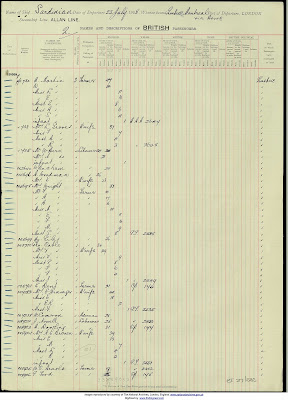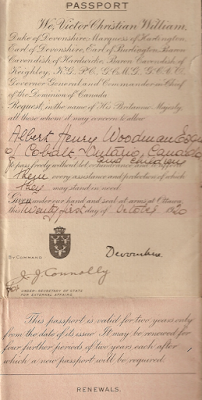The theme for this week’s 52Ancestors challenge is
Documents. In genealogical research, especially
to prove relationships, documents are an important source of information. There are many types of documents that
provide information such as birth, death, and marriage data, but there
are also documents that provide more personal information and those are so fun
to find.
I have discovered several documents for my great grandfather
Albert Henry Woodman. I’ve written about Albert before
in my Favourite Picture post and today I am writing a little more because I
have pages of his passport from 1920 and several travel documents for him. Albert
travelled quite a bit before settling in Canada when he married his second wife, Bernadette, in
1925.
The first travel document I found for Albert is a passenger
list, for the ship Sardinian which left England on Jul 23, 1908. He left there with his first wife Ethel. The
Sardinian travelled to Le Havre, France before sailing to Montreal, Quebec,
arriving Aug 5, 1908.
I found that Albert made several trips to Buffalo by finding manifests in the U.S. Border Crossings from Canada to the U.S. Albert's brother Thomas lived in Buffalo and at one time Albert had applied for Naturalization to the U.S., but this must not have occurred because he lived his life in Canada.
The manifest document below refers to his next of kin as his daughter Daisy in Deseronto and the person he is visiting is his brother Thomas. It even provides Thomas's address in Buffalo. Helpful details in my research of his family. It also confirms his arrival aboard the Sardinian in 1908 supporting what I found in the passenger lists.
The passport documents describe his appearance and confirms his birth details. This legal document also cites his children Ethel, age 12, and Robert, age 6 who were about to travel with him. It describes his features and his “National Status” which is a “British Subject.” The description of him is nice to have but other details supports previous research. The more documents you can find to support your research the better you can trust that research.
This passport was for a return to England with his children,
Ethel and Robert, aboard White Star Dominion Lines’ ship the Megantic. It arrived in Liverpool, England on November
23, 1920. On the document, U.K. Incoming Passenger Lists, it caught my
attention that in the column “Country of Intended Future Permanent Residence”
England is what he listed for all three of them. The image below shows the top of the page and the section for Albert and his two children. The one's on the far right are representative of England as the country.
It does open new questions as to his intentions because his youngest daughter, Daisy, was still in Canada. There is family lore that says Daisy was adopted by a family in Deseronto, Ontario. Was he planning to remain in England but later decided to return? I know that he returned to Canada and that he left Ethel and Robert in the care of his mother. I can only imagine the conversations with his family and some heartbreaking decisions that were made in the best interest of the children.
Albert returned to Canada alone aboard the Empress of
Britain in February 1921. On another
document, Form 30A – Ocean Arrivals, when asked the “Object in coming to Canada”
he responds, “Returning to business.”
And his response to “Why left Canada” is “visit to England.” He signed
this document on January 11, 1921. This document
supported my original understanding of his story that it was his intent to
leave Ethel and Robert in England with their grandmother. A consideration when finding information on
documents such as a passenger list is that sometimes the person responding to
the questions may have given the simple answer.
Perhaps it was just easier to say that they were all staying in England
if the children were near when he responded.
Maybe he hadn’t told them because he hadn’t completely made the decision,
or maybe he had intended to stay and later changed his mind. There is just no way to know that level of his
personal story from a document.
To make genealogical research efforts more interesting and help build our ancestors story, look beyond just the vital statistics and census records. Look for documents like travel, military, land, and estate documents. Those other types of documents broaden our ancestors’ story to makes it more personal and interesting for sharing with others.
Source: Woodman family cousin














